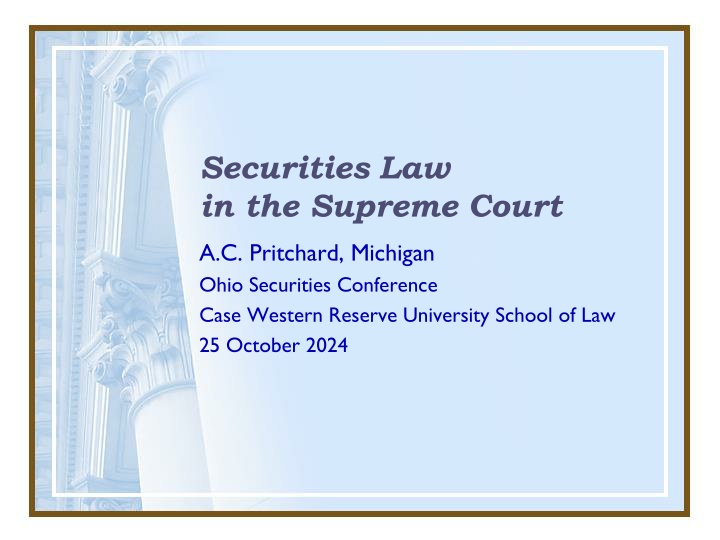
Supreme Court Securities Law Insights and Historical Perspectives
Delve into the historical evolution of securities law within the Supreme Court, spanning from initial hostility to the current era characterized by a random walk approach. Explore methodology, key cases, and significant justices' contributions. Discover the interplay between regulatory actions and litigation decisions, shedding light on the dynamic landscape of securities law.
Download Presentation

Please find below an Image/Link to download the presentation.
The content on the website is provided AS IS for your information and personal use only. It may not be sold, licensed, or shared on other websites without obtaining consent from the author. If you encounter any issues during the download, it is possible that the publisher has removed the file from their server.
You are allowed to download the files provided on this website for personal or commercial use, subject to the condition that they are used lawfully. All files are the property of their respective owners.
The content on the website is provided AS IS for your information and personal use only. It may not be sold, licensed, or shared on other websites without obtaining consent from the author.
E N D
Presentation Transcript
Securities Law in the Supreme Court A.C. Pritchard, Michigan Ohio Securities Conference Case Western Reserve University School of Law 25 October 2024
Methodology Lexis and Westlaw searches to identify all securities cases Read justices files from each case, 1936-1994 Reviewed potentially relevant memos and speeches Copied interesting stuff Phone interviews with clerks 2
The Supreme Court: The First Eighty-Five Years 1933-1937: Initial hostility 1937-1947: Enthusiastic embrace of new laws, deference to SEC 1947-1962: Backwater 1963-1972: Purposivism 1972-1987: Counterrevolution 1988 - Today: Random walk
The Waiting Game Commission s conduct arbitrary and capricious, a fishing bill Equivalent to the intolerable abuses of the Star Chamber which The Old Guard and Black Monday SEC v. Jones Playing for time North American everything. It s come to an end. Long Parliament in 1640. This is the end of this business of centralization, and I want you to go back and tell the President that we re not going let this government centralize brought that institution to an end at the hands of the http://tbn0.google.com/images?q=tbn:YNFBTHaG3xyJBM:http://www.notablebiographies.com/images/uewb_02_img0111.jpg http://tbn0.google.com/images?q=tbn:r42py5ibSHPXrM:http://content.answers.com/main/content/wp/en/thumb/0/0e/150px-George_Sutherland.gif 4
Wiley Rutledge (1943) Stanley Reed (1938) Hugo Black (1937) Robert Jackson (1941) Felix Frankfurter (1939) Frank Murphy (1940) James F. Byrnes (1941) William O. Douglas (1939) The New Deal Justices: A Reliable Court 5
A Reliable Court Why did Roosevelt succeed? Bonding Litmus test Personal familiarity Ambition 6
Judges or Experts? Chenery I (1942) 4-3 (FF, Jackson, Roberts & Stone) Agency fails to sufficiently state reasons for its actions Chenery II (1947) 5-2 (Rutledge & Burton join Murphy, Black & Reed) SEC can choose between regulation and litigation 7
Cady Roberts (1961) Obligation: 1.Access to corporate info 2.Unfairness in using info knowing unavailable to counter-party Bill Cary SEC Chair, 1961-64 8
1960s Revolution: Capital Gains Nor is it necessary, in a suit against a fiduciary, which Congress recognized the investment adviser to be, to establish all the elements required in a suit against a party to an arms-length transaction. Courts have imposed on a fiduciary an affirmative duty of utmost good faith, and full and fair disclosure of all material facts. 10
Texas Gulf Sulphur (2nd Cir. 1968) Congressional purpose that all investors should have equal access to the rewards of participation in securities transactions. It was the intent of Congress that all members of the investing public should be subject to identical market risks 11
Our corporate lawyer Generally, I think these [securities] acts have been among the best of the regulatory statutes. But the SEC has always sought to expand its reach. The history of 10b-5 is an example. 12
Insider Trading Vincent Chiarella Ray Dirks 13
Random walk post-script O Hagan (1997) Supreme Court upholds misappropriation theory Regulation FD (2000) Undermines analysts incentives to collect information Salman (2016) Affirms Dirks 14
Securities Law & the 20th C. Shifts in Supreme Court Jurisprudence Jones v. SEC (1936) SEC as Star Chamber Roosevelt Court embracing the administrative state (Chenery I & II) The Warren Court-activist court Capital Gains and purposivism Strict Constructionism securities as the paradigm Random Walk shift to 50-50 15
The random walk Years Cases Expansive Restrictive Neither 1933 44 34 7 3 Apr. 1972 May 1972 45 15 29 1 June 1987 Oct. 1987 45 20 20 5 July 2021 Total 134 69 56 9 16
Will Securities Reemerge? NO No repeat of 8 justices with agency & litigation experience SEC no longer go to agency No Powell! YES Administrative State focus of current 6- justice majority Jarkesy Loper Bright Climate disclosure rule? 17


